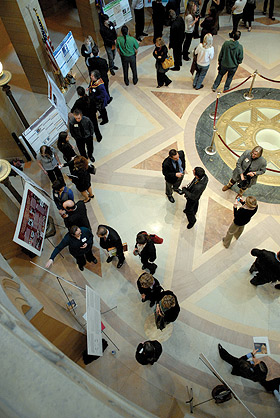News Archives - 2012
Augsburg sends scholars to the Capitol
 On Wednesday, Feb. 22, 39 students and their faculty advisors from 14 colleges will present findings of their research at the ninth annual Minnesota Private College Scholars at the Capitol event. This event gives Minnesota's legislators and the governor an opportunity to learn about the importance of research to private college and university students. It also allows students to gain experience speaking about their research work to a public audience.
On Wednesday, Feb. 22, 39 students and their faculty advisors from 14 colleges will present findings of their research at the ninth annual Minnesota Private College Scholars at the Capitol event. This event gives Minnesota's legislators and the governor an opportunity to learn about the importance of research to private college and university students. It also allows students to gain experience speaking about their research work to a public audience.
This year Augsburg College will be represented by two McNair program scholars:
Building an Infrastructure to Recognize an Image's Evoked Emotion
Chue Xue Lee, computer science, with Prof. Shana Watters
Facial emotion recognition is a subfield of computer vision. A facial emotion recognition system is a computer application for identifying or verifying a person's emotion from a digital image or a video frame. This research focuses on building a facial emotion recognition infrastructure. A facial emotion recognition algorithm is implemented and used to analyze images to determine whether a given facial image is classified as "happy" or "not happy." This type of research is important to the development of robotic systems that interact with humans and is also being used for advertisement studies.
Mesoscale Nanopatterning Using Lipid Surfactant Templating
Nana Owusu, physics, with Prof. Kevin Landmark
Contemporary research in the field of nanotechnology has demonstrated the self-assembly of nanoparticles. They spontaneously form patterns guided only by interactions among themselves and with their environment. There are various methods being investigated by researchers to template nanoparticles and transfer the patterns onto a solid substrate. This project explores the use of lipids on a Langmuir trough to organize nanoparticles at the air-water interface as well as the Langmuir-Blodgett technique to deposit the resulting monolayer. The model system that was created employed the lipid dipalmitoylphosphatidylcholine (DPPC) as a templating agent for dye-loaded polystyrene nanoparticles with a negatively charged surface. Both fluorescence microscopy and atomic force microscopy analyses of the deposited monolayers show evidence of nanoparticle patterning by DPPC. The results of this study
warrant further investigation of the technique by extending the system to different lipids, nanoparticle compositions and nanoparticle surface chemistries.
Scholars at the Capitol
Wednesday, Feb. 22, 11 a.m. - 1 p.m.
State Capitol Rotunda
Find more information on the Minnesota Private College Council website.